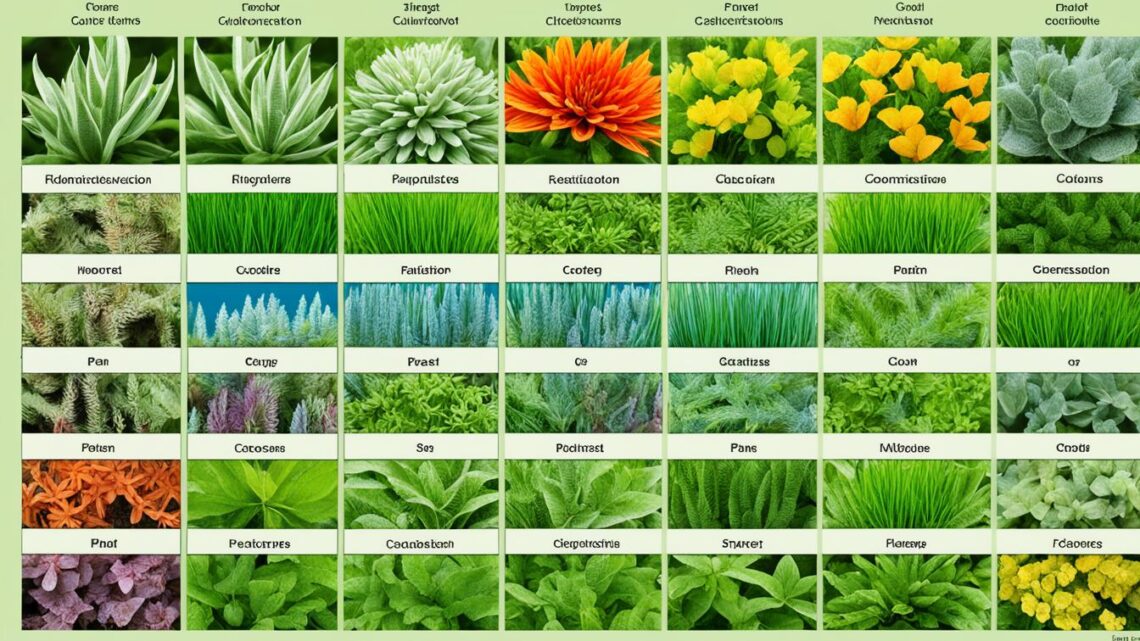
Have you ever thought about how plants are organized on our planet? The study of plant taxonomy shows us the complex life around us. It helps us see how everything is connected. From big trees to small wildflowers, learning about plant classification is exciting.
It shows us how all living things are linked. But what rules this plant world, and how can we see the beauty in our plants?
This guide will make plant classification easy to understand. We’ll look at the system that puts plants into smaller groups. You’ll learn about the naming system that gives each plant its own name.
This method helps us explore the huge world of plants. Get ready for a journey into the world of plants and discover the secrets of nature.
Understanding Plant Taxonomy
Exploring the world of plants, we find the exciting field of plant taxonomy. This system groups plants by their traits. It helps us understand the vast plant kingdom.
Hierarchical Classification System
The hierarchical classification system puts plants into groups. It starts with the kingdom and gets more specific to species. This way, botanists can see how plants are related and share traits.
Binomial Naming Convention
The binomial naming convention gives each plant a special name. It has a genus and a species part. This system helps avoid mix-ups by using common names.
Learning about plant taxonomy lets us explore the world of plants. We can see their relationships, histories, and how scientists talk about them.
| Taxonomic Rank | Example |
|---|---|
| Kingdom | Plantae |
| Division (Phylum) | Tracheophyta (Vascular plants) |
| Class | Magnoliopsida (Dicots) |
| Order | Fabales |
| Family | Fabaceae (Legumes) |
| Genus | Pisum |
| Species | Pisum sativum (Garden Pea) |
The Six Kingdoms of Life
Scientists have found six main kingdoms of life on Earth. These are the Plant Kingdom, Animal Kingdom, Fungi Kingdom, Protista Kingdom, Eubacteria Kingdom, and Archaea Kingdom. Each kingdom has its own way of living, like how it makes food and the number of cells it has.
The Plant Kingdom is full of plants that make their own food through photosynthesis. They are split into non-vascular and vascular plants, each with special traits. The Animal Kingdom has animals that need other living things for food.
The Fungi Kingdom includes many kinds of organisms that help break down old plants and animals. They get their food by absorbing it and can reproduce in different ways. The Protista Kingdom has a mix of eukaryotic organisms that use photosynthesis or absorption to get food.
The Eubacteria Kingdom and Archaea Kingdom are filled with single-celled life forms. Eubacteria are common in our daily lives, but archaebacteria live in extreme places because of their special ways of surviving.
Knowing about these six kingdoms helps us understand how diverse life is on Earth. As we keep exploring, we find more species, which helps us learn more about our world.
The National Science Foundation thinks there could be 5 million to 100 million species on Earth. We’ve found about 2 million of them so far. This shows how important it is to protect nature and keep studying it.
Plant Kingdom: The Diverse World of Plants
The plant kingdom is huge and full of life, with about 300,000 known species. It has two main groups: non-vascular plants and vascular plants. Knowing about these groups helps us see how diverse plants are.
Non-Vascular vs. Vascular Plants
Mosses and liverworts are non-vascular plants. They don’t have xylem and phloem, which are special tissues for moving water. So, they don’t have roots, stems, or leaves like other plants. They get water and nutrients directly from their surroundings.
Vascular plants have xylem and phloem, which help move water and nutrients. This lets them live in many places, from tall redwood forests to wide grasslands.
| Characteristic | Non-Vascular Plants | Vascular Plants |
|---|---|---|
| Water-conducting tissues | Absent | Present (xylem and phloem) |
| Roots, stems, and leaves | Absent | Present |
| Habitats | Typically moist environments | Wide range of terrestrial environments |
| Examples | Mosses, liverworts | Ferns, gymnosperms, angiosperms |
The plant kingdom is full of amazing plants that have adapted to many places. By learning about non-vascular and vascular plants, we see how diverse and important plants are. They play big roles in our world.
Plant Divisions: Spore-Bearers and Seed-Bearers
The plant kingdom has two main groups: spore-bearing and seed-bearing plants. Spore-bearing plants like ferns and horsetails make tiny spores to reproduce. Seed-bearing plants, including gymnosperms and angiosperms, use seeds for reproduction.
Gymnosperms: The Non-Flowering Plants
Gymnosperms, the first plants with seeds, appeared about 380 million years ago. They don’t have flowers and have seeds on special structures. These plants, including conifers and cycads, were very common before angiosperms took over around 100 million years ago.
Angiosperms: The Flowering Plants
Angiosperms, or flowering plants, are the most common and varied plants, with about 260,000 species. They have more complex vascular systems and reproductive parts than other plants. These plants are split into monocots and dicots, which affects how they grow and how herbicides work on them.
Their seeds and fruit help them spread and become the main plants on Earth.






